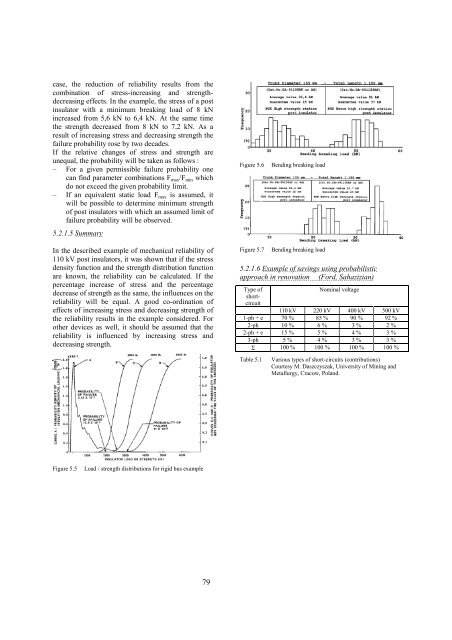The mechanical effects of short-circuit currents in - Montefiore
The mechanical effects of short-circuit currents in - Montefiore
The mechanical effects of short-circuit currents in - Montefiore
Create successful ePaper yourself
Turn your PDF publications into a flip-book with our unique Google optimized e-Paper software.
case, the reduction <strong>of</strong> reliability results from the<br />
comb<strong>in</strong>ation <strong>of</strong> stress-<strong>in</strong>creas<strong>in</strong>g and strengthdecreas<strong>in</strong>g<br />
<strong>effects</strong>. In the example, the stress <strong>of</strong> a post<br />
<strong>in</strong>sulator with a m<strong>in</strong>imum break<strong>in</strong>g load <strong>of</strong> 8 kN<br />
<strong>in</strong>creased from 5,6 kN to 6,4 kN. At the same time<br />
the strength decreased from 8 kN to 7,2 kN. As a<br />
result <strong>of</strong> <strong>in</strong>creas<strong>in</strong>g stress and decreas<strong>in</strong>g strength the<br />
failure probability rose by two decades.<br />
If the relative changes <strong>of</strong> stress and strength are<br />
unequal, the probability will be taken as follows :<br />
– For a given permissible failure probability one<br />
can f<strong>in</strong>d parameter comb<strong>in</strong>ations Fmax/Fm<strong>in</strong> which<br />
do not exceed the given probability limit.<br />
– If an equivalent static load Fmax is assumed, it<br />
will be possible to determ<strong>in</strong>e m<strong>in</strong>imum strength<br />
<strong>of</strong> post <strong>in</strong>sulators with which an assumed limit <strong>of</strong><br />
failure probability will be observed.<br />
5.2.1.5 Summary<br />
In the described example <strong>of</strong> <strong>mechanical</strong> reliability <strong>of</strong><br />
110 kV post <strong>in</strong>sulators, it was shown that if the stress<br />
density function and the strength distribution function<br />
are known, the reliability can be calculated. If the<br />
percentage <strong>in</strong>crease <strong>of</strong> stress and the percentage<br />
decrease <strong>of</strong> strength as the same, the <strong>in</strong>fluences on the<br />
reliability will be equal. A good co-ord<strong>in</strong>ation <strong>of</strong><br />
<strong>effects</strong> <strong>of</strong> <strong>in</strong>creas<strong>in</strong>g stress and decreas<strong>in</strong>g strength <strong>of</strong><br />
the reliability results <strong>in</strong> the example considered. For<br />
other devices as well, it should be assumed that the<br />
reliability is <strong>in</strong>fluenced by <strong>in</strong>creas<strong>in</strong>g stress and<br />
decreas<strong>in</strong>g strength.<br />
Figure 5.5 Load / strength distributions for rigid bus example<br />
79<br />
Figure 5.6 Bend<strong>in</strong>g break<strong>in</strong>g load<br />
Figure 5.7 Bend<strong>in</strong>g break<strong>in</strong>g load<br />
5.2.1.6 Example <strong>of</strong> sav<strong>in</strong>gs us<strong>in</strong>g probabilistic<br />
approach <strong>in</strong> renovation (Ford, Sahazizian)<br />
Type <strong>of</strong><br />
<strong>short</strong><strong>circuit</strong><br />
Nom<strong>in</strong>al voltage<br />
110 kV 220 kV 400 kV 500 kV<br />
1-ph + e 70 % 85 % 90 % 92 %<br />
2-ph 10 % 6 % 3 % 2 %<br />
2-ph + e 15 % 5 % 4 % 3 %<br />
3-ph 5 % 4 % 3 % 3 %<br />
Σ 100 % 100 % 100 % 100 %<br />
Table 5.1 Various types <strong>of</strong> <strong>short</strong>-<strong>circuit</strong>s (contributions)<br />
Courtesy M. Daszczyszak, University <strong>of</strong> M<strong>in</strong><strong>in</strong>g and<br />
Metallurgy, Cracow, Poland.











